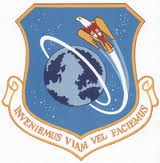
Sunnyvale Center
History of Onizuka
 Onizuka Air Force Station was built in 1960 on land purchased from the Lockheed Corporation.
Part of the new facility included a massive multi-storied, windowless, high-security
building that led to its moniker, "The Blue Cube." Originally it was officially named
the Air Force Satellite Test Center. In later years its name was changed to the Air
Force Satellite Control Facility, the Sunnyvale Air Force Station and was also referred
to as Lockheed's "Building 100."
Onizuka Air Force Station was built in 1960 on land purchased from the Lockheed Corporation.
Part of the new facility included a massive multi-storied, windowless, high-security
building that led to its moniker, "The Blue Cube." Originally it was officially named
the Air Force Satellite Test Center. In later years its name was changed to the Air
Force Satellite Control Facility, the Sunnyvale Air Force Station and was also referred
to as Lockheed's "Building 100."
On January 28, 1986 the Space Shuttle Challenger broke apart 73 seconds into its flight due to a malfunctioning O-ring and disintegrated over the Atlantic Ocean. The 7-member crew all perished in the disaster. Later that year the site was renamed "Onizuka Air Force Base" in honor of astronaut Lt. Col. Ellison Shoji Onizuka who had been part of the crew. Onizuka, a native of Hawaii, was serving as Mission Specialist and was the first Asian American in space. On January 26, 1994 the base was renamed Onizuka Air Force Station.
The site was home to the Air Force's Air Force Satellite Control Facility (AFSCF), which was a space command and control unit. During the cold war and the space race the site figured prominently in operations, but its activities were kept top secret. At its peak, the site housed more than 1,200 people. It helped to track numerous satellites and missions including Gemini 8 in 1966 under the command of Neil Armstrong. During this mission, Armstrong, who later would be the first human to walk on the moon, was the first to successfully carry out a docking mission, rendezvousing with an unmanned Agena vehicle.
The Air Force also credits the base with being the birthplace of the Corona program (first declassified in 1995). This program, under the direction of the National Reconnaissance Office (NRO), deployed reconnaissance satellites that were used for photographic surveillance of the areas including the Soviet Union and the Peoples Republic of China. A reentry capsule (nicknamed "bucket") carrying film would separate from the satellite and fall to earth where it would ideally be caught mid-air by a plane via an airborne claw (also known as "star-catching").
In April 2007 the mission of the NRO at Onizuka AFS ended after 46 years and in 2010 the base was officially closed.
Foothill - De Anza Community College District at Onizuka
Foothill-De Anza has been operating an off-site campus for almost 30 years. In 2006, voters approved a bond measure that included funds to secure a permanent site for an off-campus education center. After searching for a suitable location for several years, the district in 2012 obtained 9.15 acres of the 18.9-acre Onizuka property free of charge from the U.S. Department of Education through the federal public benefit conveyance process. The district then selected the Lionakis architectural firm to build a multi-story, 50,000-foot state-of-the-art instructional facility.
Share Your History of Onizuka
Do you have stories, photos or memorabilia about the Onizuka Airforce Station? If you would like to share your information, please contact Simon Pennington, Associate Vice President, Marketing at penningtonsimon@fhda.edu.

Questions?
We're Here to Help!
Long Huynh, Sunnyvale Center
408.745.8024
1070 Innovation Way, Sunnyvale
Sunnyvale Center Closed Dec. 15–Jan. 2Due to building construction, our Sunnyvale Center team will be available by email and for zoom appointments only during winter recess hours. In-person services will resume Monday, Jan. 5. |
Connect with Us


